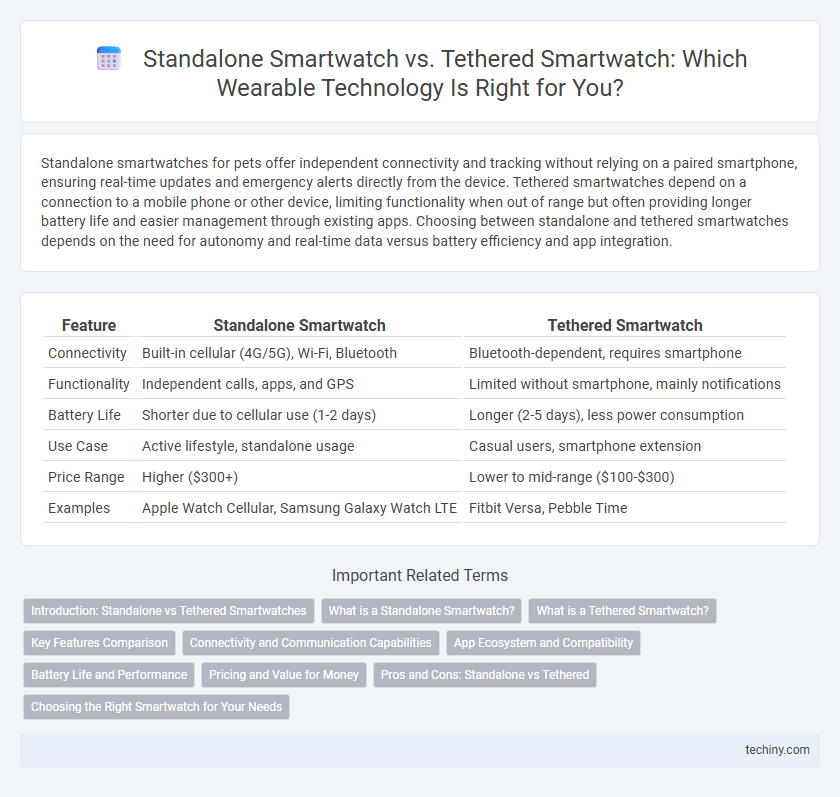Standalone smartwatches for pets offer independent connectivity and tracking without relying on a paired smartphone, ensuring real-time updates and emergency alerts directly from the device. Tethered smartwatches depend on a connection to a mobile phone or other device, limiting functionality when out of range but often providing longer battery life and easier management through existing apps. Choosing between standalone and tethered smartwatches depends on the need for autonomy and real-time data versus battery efficiency and app integration.
Table of Comparison
| Feature | Standalone Smartwatch | Tethered Smartwatch |
|---|---|---|
| Connectivity | Built-in cellular (4G/5G), Wi-Fi, Bluetooth | Bluetooth-dependent, requires smartphone |
| Functionality | Independent calls, apps, and GPS | Limited without smartphone, mainly notifications |
| Battery Life | Shorter due to cellular use (1-2 days) | Longer (2-5 days), less power consumption |
| Use Case | Active lifestyle, standalone usage | Casual users, smartphone extension |
| Price Range | Higher ($300+) | Lower to mid-range ($100-$300) |
| Examples | Apple Watch Cellular, Samsung Galaxy Watch LTE | Fitbit Versa, Pebble Time |
Introduction: Standalone vs Tethered Smartwatches
Standalone smartwatches operate independently with built-in cellular connectivity, enabling calls, messaging, and app usage without a smartphone. Tethered smartwatches depend on Bluetooth connection to a smartphone for most functionalities, relying on the phone's network and processing power. Choosing between standalone and tethered watches involves prioritizing autonomy, battery life, and usage scenarios in wearable technology.
What is a Standalone Smartwatch?
A standalone smartwatch operates independently without requiring a connection to a smartphone, featuring built-in cellular capabilities such as LTE or 5G for calls, messaging, and internet access. It integrates GPS, fitness tracking, and app functionality directly on the device, enhancing mobility and convenience. Leading models like the Apple Watch Series 8 and Samsung Galaxy Watch 5 exemplify this fully self-sufficient wearable technology.
What is a Tethered Smartwatch?
A tethered smartwatch relies on a constant Bluetooth connection to a smartphone for full functionality, including calls, messages, and app notifications. Unlike standalone smartwatches, tethered models do not have independent cellular connectivity or GPS features, limiting their usability without the paired phone. These devices are ideal for users who want to extend their phone's capabilities to their wrist without needing separate cellular plans.
Key Features Comparison
Standalone smartwatches offer integrated LTE connectivity, enabling independent calls, messaging, and GPS tracking without relying on a smartphone. Tethered smartwatches depend on Bluetooth connections to smartphones for notifications, apps, and location services, limiting usability when separated. Battery life tends to be longer in tethered models due to reduced communication demands, while standalone devices provide enhanced mobility and self-sufficiency through onboard processing and cellular capabilities.
Connectivity and Communication Capabilities
Standalone smartwatches feature built-in cellular connectivity, enabling users to make calls, send messages, and access the internet independently of a smartphone. Tethered smartwatches rely on Bluetooth or Wi-Fi connections to link with a paired smartphone for communication and data synchronization. The choice between standalone and tethered devices significantly impacts user freedom, battery life, and the range of communication features available.
App Ecosystem and Compatibility
Standalone smartwatches offer a robust app ecosystem with native applications designed specifically for independent operation, enhancing user experience without relying on a smartphone. Tethered smartwatches primarily depend on smartphone compatibility, limiting their app choices to those supported via Bluetooth connection and often requiring paired device integration for full functionality. Compatibility in standalone models extends to direct cellular connectivity, GPS, and app updates, while tethered models focus on seamless synchronization with smartphones running iOS or Android platforms.
Battery Life and Performance
Standalone smartwatches feature integrated cellular connectivity, allowing independent operation without reliance on smartphones, which often results in higher power consumption but enhanced functionality. Tethered smartwatches depend on Bluetooth connections to smartphones, offering extended battery life through reduced power demands but limited performance when offline. Users prioritizing long battery life may prefer tethered devices, while those valuing comprehensive features and mobility benefit from standalone smartwatches.
Pricing and Value for Money
Standalone smartwatches typically come with higher price points due to integrated cellular connectivity and independent functionality, offering better value for users needing phone-free convenience. Tethered smartwatches, generally more affordable, rely on smartphone connections for full features, making them cost-effective for users seeking basic notifications and fitness tracking. Evaluating standalone versus tethered options involves balancing budget constraints against desired autonomy and long-term device utility.
Pros and Cons: Standalone vs Tethered
Standalone smartwatches offer the advantage of independence from smartphones, allowing users to make calls, stream music, and access apps via cellular connectivity, enhancing convenience and mobility. However, they tend to have shorter battery life and higher costs compared to tethered smartwatches, which rely on a paired smartphone for functionality, resulting in longer battery endurance and often lower prices. Tethered smartwatches benefit from seamless integration with mobile devices for notifications and health tracking but depend heavily on the smartphone's connection, limiting functionality when the phone is out of range.
Choosing the Right Smartwatch for Your Needs
Standalone smartwatches offer independent cellular connectivity, enabling calls, messages, and apps without a paired smartphone, ideal for users seeking full mobility. Tethered smartwatches rely on Bluetooth connections to a smartphone for notifications and data synchronization, suitable for those prioritizing extended battery life and seamless app integration. Evaluating lifestyle, communication habits, and fitness tracking requirements ensures selecting the optimal smartwatch type tailored to individual needs.
Standalone Smartwatch vs Tethered Smartwatch Infographic

 techiny.com
techiny.com